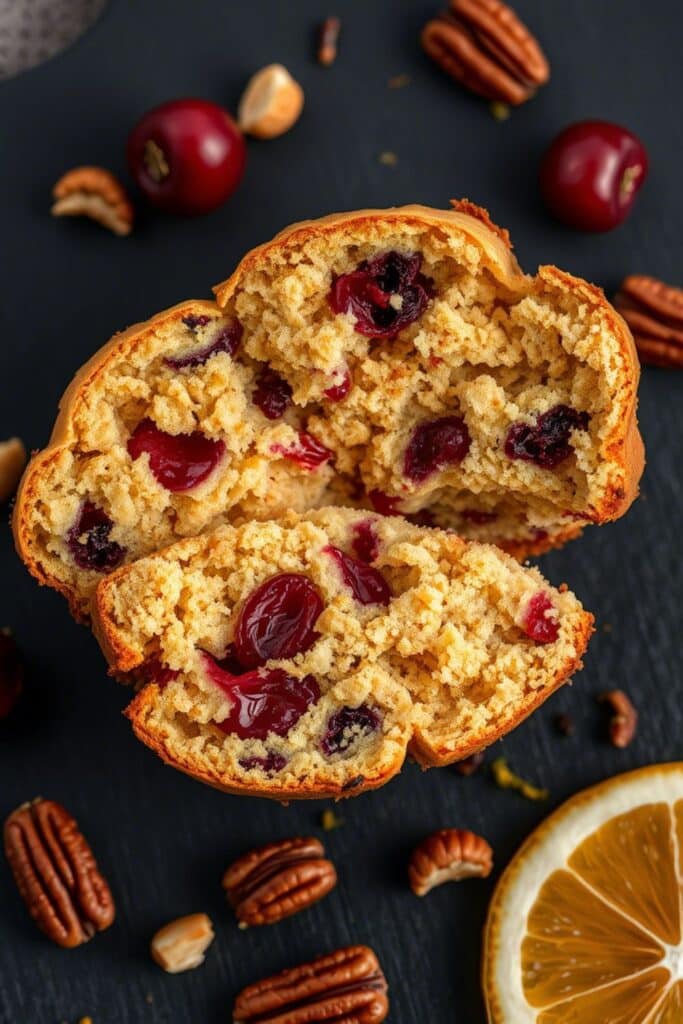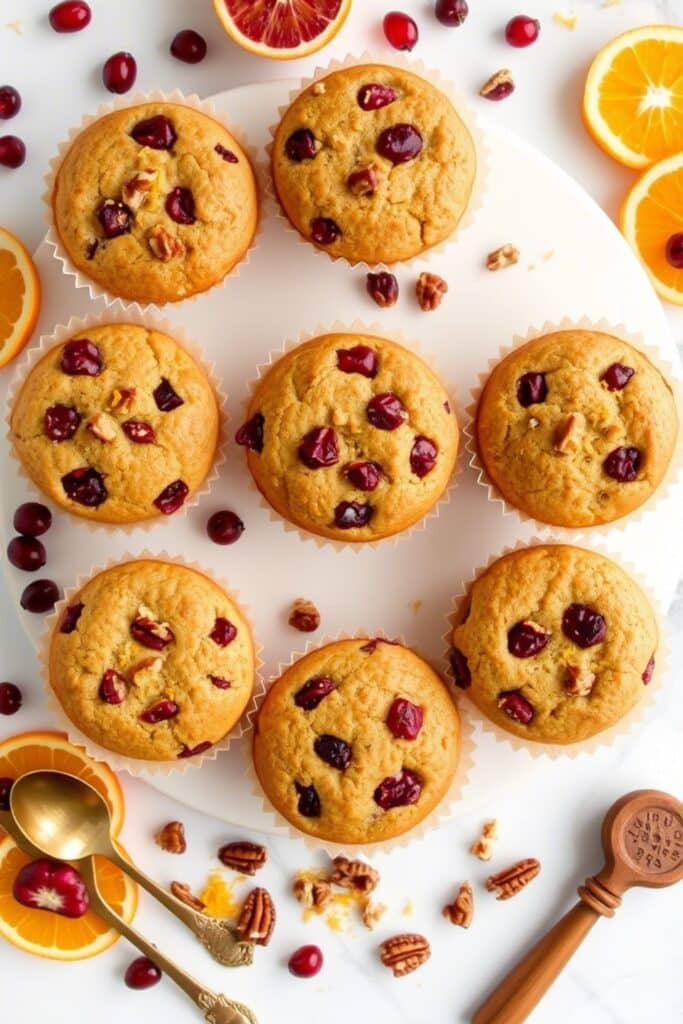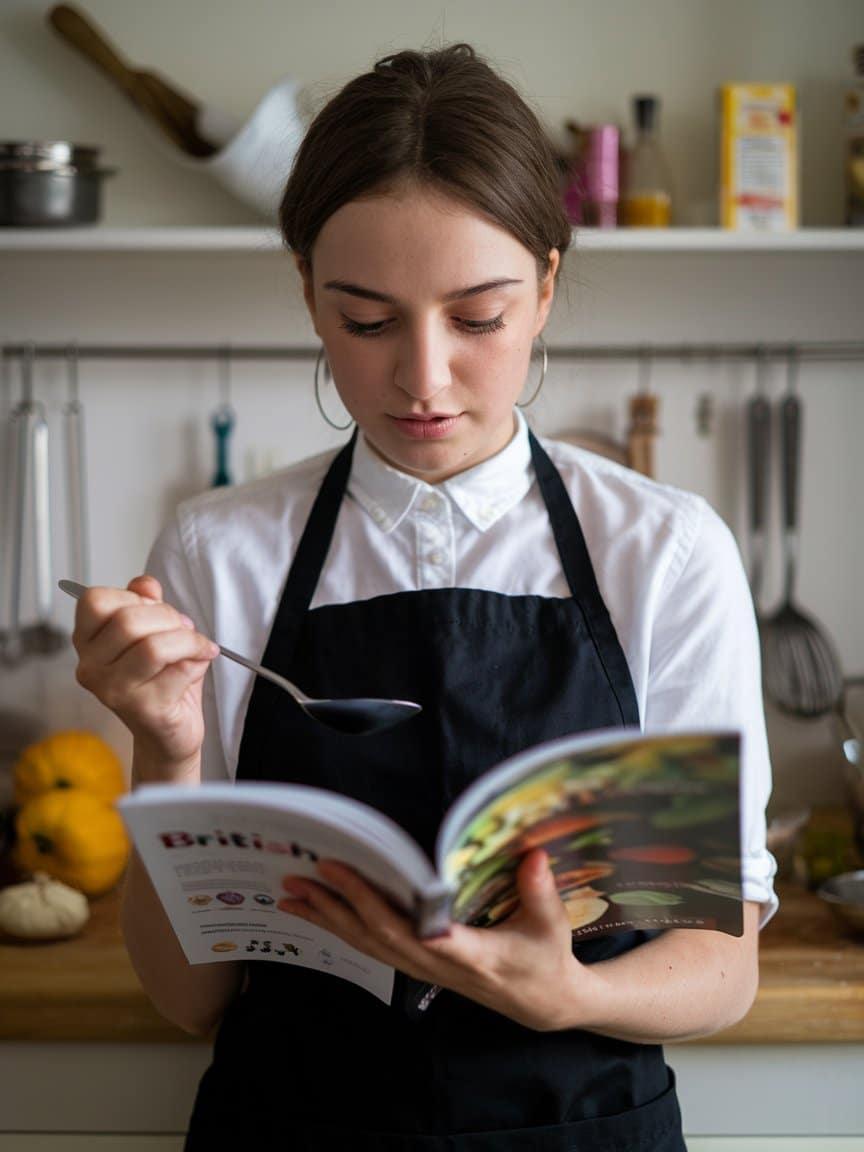Last November, while judging a regional baking competition, I encountered a muffin that stopped me mid-bite. The baker had achieved something remarkable a perfect harmony between tart cranberries, bright citrus, and earthy pecans that sang together rather than competed. That moment reminded me why this particular combination has become a cornerstone of American bakery menus.
These aren’t your average coffee-shop muffins. Cranberry, Orange & Pecan Muffins represent the pinnacle of what I call “architectural baking” where each ingredient plays a structural role in both flavor and texture. The cranberries provide acidic punctuation, the orange zest delivers aromatic oils that perfume every crumb, and the pecans add that essential textural contrast that transforms a simple quick bread into something transcendent.
What makes this recipe truly exceptional is its ability to showcase three distinct flavor profiles while maintaining perfect moisture balance something that separates professional-quality muffins from their dense, overmixed counterparts.
Ingredients & Substitutions
The foundation of exceptional muffins begins with understanding your ingredients at a molecular level. Here’s what you’ll need, listed in order of incorporation:
Dry Ingredients:
- 2½ cups all-purpose flour (320g)
- ¾ cup granulated sugar (150g)
- 2½ teaspoons baking powder
- ½ teaspoon salt
- Zest of 2 large oranges
Wet Ingredients:
- ⅓ cup melted unsalted butter (75g)
- 1 large egg, room temperature
- 1 cup whole milk (240ml)
- ¼ cup fresh orange juice
- 1 teaspoon vanilla extract
Mix-ins:
- 1 cup fresh cranberries (or ¾ cup dried)
- ¾ cup toasted pecan halves, roughly chopped
The flour choice here is crucial. All-purpose flour with its moderate protein content (10-12%) creates the ideal crumb structure sturdy enough to support the mix-ins without becoming tough. Bread flour will make your muffins too chewy, while cake flour won’t provide enough structure for the hefty cranberries and pecans.
For dietary modifications, I’ve had excellent results substituting up to half the all-purpose flour with whole wheat pastry flour. This adds complexity without compromising texture. Gluten-free bakers should use a 1:1 substitute blend that includes xanthan gum Cup4Cup or King Arthur’s Gluten-Free Flour work beautifully.
The sugar balance is intentionally restrained. These muffins shouldn’t taste like dessert; they need enough sweetness to balance the cranberry tartness while allowing the orange’s natural brightness to shine through.
Fresh cranberries are non-negotiable during peak season (October through December). Their burst of tartness and textural pop can’t be replicated. However, if you must use dried cranberries, reduce the quantity to ¾ cup and give them a quick soak in warm orange juice to plump them up.
Pecans should always be toasted before incorporation. Raw pecans taste flat and oily. A quick 5-7 minutes in a 350°F oven transforms them into aromatic, crispy gems that won’t get soggy in the batter.
Step-by-Step Instructions
Preparation Phase: Preheat your oven to 375°F and line a 12-cup muffin tin with paper liners. The temperature is deliberately high we want rapid rise and golden tops. Position your rack in the center of the oven for even heat distribution.

Toast your pecans first. Spread them on a baking sheet and toast for 5-7 minutes until fragrant. Let them cool completely before chopping hot nuts will create steam in your batter.
The Dry Mix: In a large bowl, whisk together flour, sugar, baking powder, and salt. This isn’t just combining ingredients; you’re aerating the flour and ensuring even distribution of leavening agents. Add the orange zest and whisk again. The oils from the zest will perfume the entire dry mixture.
Here’s where many home bakers go wrong: they add the wet ingredients too quickly. The secret to tender muffins lies in gentle handling and proper hydration.
Wet Ingredient Mastery: In a separate bowl, whisk the melted butter with the egg until emulsified. This prevents the butter from seizing when it hits the cold milk. Gradually whisk in the milk, orange juice, and vanilla. The mixture should be smooth and homogeneous.
The Critical Folding Technique: Pour the wet ingredients into the dry mixture and begin folding with a large spoon or rubber spatula. Here’s the key: you want to see streaks of dry flour when you add the cranberries and pecans. This is called the “80% rule” stop mixing when the batter is 80% combined.
Gently fold in the cranberries and pecans with no more than 10-12 strokes. The batter will look lumpy and imperfect this is exactly what you want. Overmixing develops gluten, leading to tough, dense muffins with peaked tops.
Baking Excellence: Divide the batter evenly among muffin cups, filling each about ¾ full. I use an ice cream scoop for consistency it ensures uniform size and professional appearance.
Bake for 18-22 minutes, rotating the pan halfway through for even browning. The tops should be golden and spring back when lightly pressed. A toothpick inserted in the center should come out with just a few moist crumbs completely clean means overbaked.
Cool in the pan for 5 minutes before transferring to a wire rack. This brief rest allows the crumb to set without becoming soggy from trapped steam.
Cooking Techniques & Science
The science behind perfect muffins revolves around two critical factors: gluten development and moisture retention. When flour meets liquid, gluten proteins begin forming networks. In bread, we want this; in muffins, we’re trying to minimize it.
The “muffin method” keeping wet and dry ingredients separate until the last moment prevents excessive gluten development. The high oven temperature creates rapid steam, which pushes the batter upward before the gluten network can tighten.
Orange zest plays a dual role here. The essential oils provide flavor, but they also coat flour proteins, further inhibiting gluten formation. This is why citrus-based quick breads tend to be more tender than their plain counterparts.
Cranberries present a unique challenge. Their high acidity can react with baking powder, potentially affecting rise. Fresh cranberries also release moisture during baking, which can make surrounding crumb soggy. The solution is proper distribution and not overpacking the batter.
The pecans contribute healthy fats that improve moisture retention and add richness without making the muffins heavy. Toasting them removes surface moisture that could otherwise create soggy pockets in the finished product.
Serving & Pairing Suggestions
These muffins shine brightest when served slightly warm about 20 minutes out of the oven. The cranberries are still slightly firm, the pecans maintain their crunch, and the orange oils are at their most aromatic.

For breakfast service, pair them with cultured butter and quality jam. The tangy butter complements the orange while balancing the cranberry tartness. A spoonful of apricot or fig jam adds luxurious sweetness without competing with the existing flavors.
Coffee pairings deserve special attention. Medium roast coffees with bright acidity think Ethiopian or Kenyan beans create beautiful harmony with the citrus notes. Avoid dark roasts that might overpower the delicate orange essence.
For afternoon service, consider a light dusting of powdered sugar or a simple orange glaze made from powdered sugar, orange juice, and zest. Keep it minimal these muffins don’t need heavy-handed decoration.
They also make exceptional bread pudding when day-old. The cranberries intensify in flavor, and the pecans add wonderful texture to the custard base.
Storage and Make-Ahead Tips
Properly stored, these muffins maintain peak quality for 3-4 days at room temperature in an airtight container. The key is ensuring they’re completely cooled before storage any residual heat creates condensation that leads to soggy bottoms.
For longer storage, wrap individually in plastic wrap and freeze for up to three months. Thaw at room temperature or warm briefly in a 300°F oven.
The batter can be made ahead and refrigerated overnight, though you’ll lose some leavening power. Add an extra ¼ teaspoon of baking powder to compensate.
Professional Variations
Glazed Version: Whisk together 1 cup powdered sugar, 3 tablespoons orange juice, and 1 teaspoon zest for a simple glaze. Drizzle over cooled muffins.

Streusel Top: Combine ¼ cup flour, ¼ cup sugar, 2 tablespoons cold butter, and a pinch of cinnamon. Sprinkle over batter before baking for bakery-style tops.
White Chocolate Addition: Fold in ½ cup white chocolate chips with the cranberries and pecans for extra richness.
Healthier Alternative: Substitute half the all-purpose flour with whole wheat pastry flour and reduce sugar by 2 tablespoons. Add 2 tablespoons of honey to the wet ingredients to maintain moisture.
The beauty of this recipe lies in its flexibility while maintaining structural integrity. Each variation builds on the solid foundation of proper technique and balanced flavors.
These muffins represent everything I love about professional baking technical precision combined with creative expression. Master this recipe, and you’ll understand the difference between good muffins and great ones. The secret isn’t in exotic ingredients or complicated techniques; it’s in respecting the fundamentals and letting quality ingredients speak for themselves.
Frequently Asked Questions?
Q: Why do my muffins turn out dense and heavy?
A: The most common culprit is overmixing the batter. Once you add the wet ingredients to the dry, fold gently just until combined the batter should look lumpy with streaks of flour visible. Also ensure your baking powder is fresh (replace every 6 months) and don’t pack the flour when measuring.
Q: Can I use frozen cranberries instead of fresh?
A: Absolutely, but don’t thaw them first. Toss frozen cranberries directly into the batter they’ll thaw during baking and release less moisture than pre-thawed berries. You might need an extra minute or two of baking time.
Q: My muffins stick to the paper liners. How can I prevent this?
A: This usually happens when muffins are stored while still warm, creating steam that makes liners stick. Always cool completely before storing. Also, invest in quality paper liners cheap ones often stick regardless of technique.
Q: How can I tell when the muffins are perfectly done?
A: Look for golden-brown tops that spring back when lightly touched. A toothpick should come out with just a few moist crumbs not wet batter, but not completely clean either. The tops should feel firm but not hard.
Q: Can I make mini muffins with this recipe?
A: Yes! Reduce baking time to 12-15 minutes at 375°F. Mini muffins bake faster due to their smaller size, so watch them carefully after 10 minutes. You’ll get approximately 36 mini muffins from this recipe.

Veronica is a passionate food enthusiast with over three years of experience in exploring and writing about diverse cuisines. Her expertise lies in reviewing restaurants, sharing creative recipes, and discovering the latest food trends. As the voice behind FoodieRecap.com, Anju brings fresh perspectives and culinary insights to her audience.
